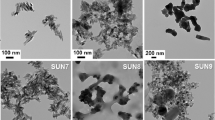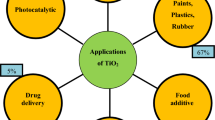Abstract
The article describes a method for the determination of titanium oxide nanoparticles (TiO2NPs) in sunscreens using N-doped graphene quantum dots (N-GQDs). The TiO2-NPs are first extracted from the highly lipophilic sunscreen via liquid-liquid extraction. Subsequent fluorimetric analysis of the extracts is based on the quenching effect exerted by TiO2NPs on the fluorescence of N-GQDs. The effect is assumed to be due to an electrostatic interaction and/or hydrogen bonding between the particles. The limit of detection for TiO2NPs is 1.4 μg⋅g‾1. The precision at a 5 μg⋅g‾1 concentration of TiO2NPs is 6.95 %. The optimized procedure was successively applied to the determination of TiO2 NPs in sunscreens with different sun protection factors.

A method for the determination of TiO2 nanoparticles (NPs) in sunscreens using N-doped graphene quantum dots (N-GQDs) is described. TiO2 NPs are extracted via liquid-liquid extraction and subsequently quantified by fluorimetric analysis of the quenching effect on the fluorescence of N-GQDs.






Similar content being viewed by others
References
Contado C, Pagnoni A (2008) TiO2 in commercial sunscreen lotion: flow field-flow fractionation and ICP-AES together for size analysis. Anal Chem 80:7594–7608. doi:10.1021/ac8012626
Weir A, Westerhoff P, Fabricius L, Hristovski K, von Goetz N (2012) Titanium dioxide nanoparticles in food and personal care products. Environ Sci Technol 46:2242–2250. doi:10.1021/es204168d
Nazarenko Y, Zhen H, Han T, Lioy PJ, Mainelis G (2012) Potential for inhalation exposure to engineered nanoparticles from nanotechnology-based cosmetic powders. Environ Health Perpect 120:885–892. doi:10.1289/ehp.1104350
Salvador A, Chisvert A (2005) Sunscreen analysis: a critical survey on UV filters determination. Anal Chim Acta 537:1–14. doi:10.1016/j.aca.2005.01.055
Nischwitz V, Goenaga-Infante H (2012) Improved sample preparation and quality control for the characterisation of titanium dioxide nanoparticles in sunscreens using flow field flow fractionation on-line with inductively coupled plasma mass spectrometry. J Anal At Spectrom 27:1084–1092. doi:10.1039/C2JA10387G
Popov AP, Lademann J, Priezzhev AV, Myllylä R (2005) Effect of size of TiO2 nanoparticles embedded into stratum corneum on ultraviolet-a and ultraviolet-B sun-blocking properties of the skin. J Biomed Opt 10:1–9. doi:10.1117/1.2138017
Furukawa F, Doi Y, Suguro M, Morita O, Kuwahara H, Masunaga T, Hatekeyama Y, Mori F (2011) Lack of skin carcinogenicity of topically applied titanium dioxide nanoparticles in the mouse. Food Chem Toxicol 49:744–749. doi:10.1016/j.fct.2010.11.036
Freyre-Fonseca V, Delgado-Buenrostro NL, Gutierrez-Cirlos EB, Calderon-Torres CM, Cabellos-Avelar T, Sanchez-Perez Y, Pinzon E, Torres I, Molina-Jijon E, Zazueta C, Pedraza-Chaverri J, Garcia-Cuellar CM, Chirino YI (2011) Titanium dioxide nanoparticles impair lung mitochondrial function. Toxicol Lett 202:111–119. doi:10.1016/j.toxlet.2011.01.025
Tsuji JS, Maynard AD, Howard PC, James JT, Lam CW, Warheit DB, Santamaria AB (2006) Research strategies for safety evaluation of nanomaterials, part IV: risk assessment of nanoparticles. Toxicol Sci 89:42–50. doi:10.1093/toxsci/kfi339
Kim YS, Kim BM, Park SC, Jeong HJ, Chang JS (2006) A novel volumetric method for quantitation of titanium dioxide in cosmetics. J Cosmet Sci 57:377–381. doi:10.1111/j.1467-2494.2007.00369_2.x
Mason JT (1980) Quantitative determination of titanium in a commercial sunscreen formulation by atomic absorption spectrometry. J Pharm Sci 69:101–102. doi:10.1002/jps.2600690131
Salvador A, Pascual-Martí MC, Adell JR, Requeni A, March JG (2000) Analytical methodologies for atomic spectrometric determination of metallic oxides in UV sunscreen creams. J Pharm Biomed Anal 22:301–306. doi:10.1016/S0731-7085(99)00286-1
Melquiades FL, Ferreira DD, Appoloni CR, Lopes F, Lonni AG, Oliveira FM, Duarte JC (2008) Titanium dioxide determination in sunscreen by energy dispersive X-ray fluorescence methodology. Anal Chim Acta 613:135–143. doi:10.1016/j.aca.2008.02.058
Contado C, Pagnonia A (2010) TiO2 Nano- and micro-particles in commercial foundation creams: field flow-fractionation techniques together with ICP-AES and SQW voltammetry for their characterization. Anal Methods 2:1112–1124. doi:10.1039/C0AY00205D
Samontha A, Shiowatana J, Siripinyanond A (2011) Particle size characterization of titanium dioxide in sunscreen products using sedimentation field-flow fractionation-inductively coupled plasma-mass spectrometry. Anal Bioanal Chem 399:973–978. doi:10.1007/s00216-010-4298-z
Krystek P, Tentschert J, Nia Y, Trouiller B, Noël L, Goetz ME, Papin A, Luch A, Guérin T, de Jong WH (2014) Method development and inter-laboratory comparison about the determination of titanium from titanium dioxide nanoparticles in tissues by inductively coupled plasma mass spectrometry characterisation of nanomaterials in biological samples. Anal Bioanal Chem 406:3853–3861. doi:10.1007/s00216-013-7580-z
Geertsen V, Tabarant M, Spalla O (2014) Behavior and determination of titanium dioxide nanoparticles in nitric acid and river water by ICP spectrometry. Anal Chem 86:3453–3460. doi:10.1021/ac403926r
Dong Y, Chen C, Zheng X, Gao L, Cui Z, Yang H, Guo C, Chi Y, Li CM (2012) One-step and high yield simultaneous preparation of single- and multi-layer graphene quantum dots from CX-72 carbon black. J Mater Chem 22:8764–8766. doi:10.1039/C2JM30658A
Kim S, Hwang SW, Kim MK, Shin DY, Shin DH, Kim CO, Yang SB, Park JH, Hwang E, Choi SH, Ko G, Sim S, Sone C, Choi HJ, Bae S, Hong BH (2012) Anomalous behaviors of visible luminescence from graphene quantum dots: interplay between size and shape. ACS Nano 6:8203–8208.doi:10.1021/nn302878r.
Shen J, Zhu Y, Yang X, Zong J, Zhang J, Li C (2012) One-pot hydrothermal synthesis of graphene quantum dots surface-passivated by polyethylene glycol and their photoelectric conversion under near-infrared light. New J Chem 36:97–101. doi:10.1039/C1NJ20658C
Benítez–Martínez S, Valcárcel M (2014) Graphene quantum dots as sensor for phenols in olive oil. Sensors Actuators B Chem 197:350–357. doi:10.1016/j.snb.2014.03.008
Benítez-Martínez S, López-Lorente AI, Valcárcel M (2014) Graphene quantum dots sensor for the determination of graphene oxide in environmental water samples. Anal Chem 86:12279–12284. doi:10.1021/ac5035083
Li X, Zhu S, Xu B, Ma K, Zhang K, Yang B, Tian W (2013) Self-assembled graphene quantum dots induced by cytochrome c: a novel biosensor for trypsin with remarkable fluorescence enhancement. Nanoscale 5:7776–7779. doi:10.1039/C3NR00006K
Dong Y, Shao J, Chen C, Li H, Wang R, Chi Y, Lin X, Chen G (2012) Blue luminescent graphene quantum dots and graphene oxide prepared by tuning the carbonization degree of citric acid. Carbon 50:4738–4743. doi:10.1016/j.carbon.2012.06.002
Tam TV, Trung NB, Kim HR, Chung JS, Choi WM (2014) One-pot synthesis of N-doped graphene quantum dots as a fluorescent sensing platform for Fe3+ ions detection. Sensors Actuators B Chem 202:568–573. doi:10.1016/j.snb.2014.05.045
Qu D, Zheng M, Zhang L, Zhao H, Xie Z, Jing X, Haddad RE, Fan H, Sun Z (2014) Formation mechanism and optimization of highly luminescent N-doped graphene quantum dots. Sci Reports 4:5294. doi:10.1038/srep05294
Li C, Wang F, Yu JC (2011) Seminconductor/biomolecular composites for solar energy applications. Energy Environ Sci 4:100–113. doi:10.1039/C0EE00162G
Campbell WM, Burrell AK, Officer DL, Jolley KW (2004) Porphyrins as light harvesters in the dye-sensitised TiO2 solar cell. Coord Chem Rev 248:1363–1379. doi:10.1016/j.ccr.2004.01.007
Langel W, Menken L (2003) Simulation of the interface between titaniun oxide and amino acids of anatase and rutenium surface. Surf Sci 538:1–9. doi:10.1016/S0039-6028(03)00723-4
Wu ZL, Gao MX, Wang TT, Wan XY, Zheng LL, Huang CZ (2014) A general quantitative pH sensor developed with dicyandiamide N-doped high quantum yield graphene quantum dots. Nanoscale 6:3868–3874. doi:10.1039/c3nr06353d
Yan Z, Yu Y, Chen J (2015) Glycine-functionalized carbon quantum dots as chemiluminescence sensitization for detection of m-phenylendiamine. Anal Methods 7:1133–1139. doi:10.1039/C4AY02124J
Li L, Li L, Wang C, Liu K, Zhu R, Qiang H, Lin Y (2015) Synthesis of nitrogen-doped and amino acid-functionalized graphene quantum dots from glycine, and their application to the fluorimetric determination of ferric ion. Microchim Acta 182:763–770. doi:10.1007/s00604-014-1383-6
Yang D, Velamakanni A, Bozoklu G, Park S, Stoller M, Piner RD, Stankovich S, Jung I, Field DA, Ventrice Jr CA, Ruoff RS (2009) Chemical analysis of graphene oxide films after heat and chemical treatments by X-ray photoelectron and micro-Raman spectroscopy. Carbon 47:145–152. doi:10.1016/j.carbon.2008.09.045
Acknowledgments
The authors wish to thank Spain’s Ministry of Economy and Competitivity for funding Project CTQ2014-52939R and Junta de Andalucía for Project FQM4801. S. Benítez-Martínez is also grateful to Junta de Andalucía for the award of a Research Training Fellowship.
Author information
Authors and Affiliations
Corresponding author
Ethics declarations
Conflict of interest
The authors declare no competing financial interest.
Electronic supplementary material
ESM 1
(DOCX 207 kb)
Rights and permissions
About this article
Cite this article
Benítez-Martínez, S., López-Lorente, Á.I. & Valcárcel, M. Determination of TiO2 nanoparticles in sunscreen using N-doped graphene quantum dots as a fluorescent probe. Microchim Acta 183, 781–789 (2016). https://doi.org/10.1007/s00604-015-1696-0
Received:
Accepted:
Published:
Issue Date:
DOI: https://doi.org/10.1007/s00604-015-1696-0




